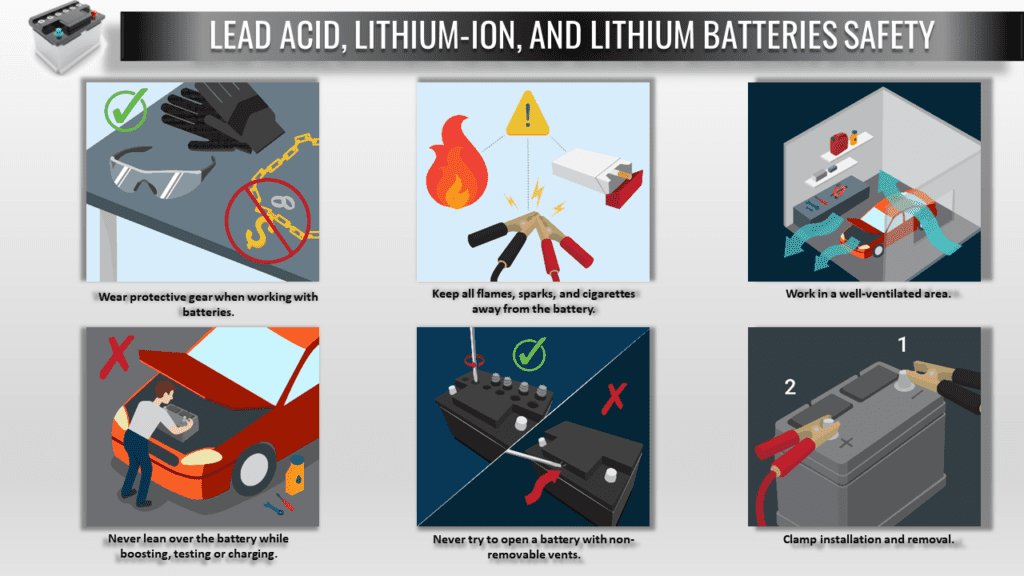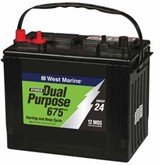LEAD-ACID, LITHIUM-ION, AND LITHIUM BATTERIES SAFETY
9 min readAutomotive batteries contain hydrogen-oxygen gases that can be explosive. The acid inside the battery is highly corrosive and can cause severe burns on your skin if it leaks out of the battery. To help avoid danger and injury, in this article you will be familiar with the type of batteries and Batteries safety Especially when handling and working with different types of batteries. Handle with care as the acid could leak out if the battery is cracked or damaged.


What are lead acid, lithium-ion, and lithium batteries?
Lead-Acid
Lead-acid batteries are relatively common large-capacity rechargeable batteries. They are used in automobiles, electric vehicles, boats, and uninterruptible power supplies (UPS).
These batteries are composed of a number of individual cells that contain layers of lead alloy plates immersed in an electrolyte solution. Small quantities of other metals, such as antimony, calcium, tin, selenium, are often added to the lead to provide more mechanical strength and enhance electrical properties. The electrolyte solution is typically comprised of 35% sulfuric acid and 65% water, and energy is produced when the sulfuric acid comes in contact with the lead plate and causes a chemical reaction.
There are two main categories of lead-acid batteries: vented lead-acid (also called VLA or spillable) and valve-regulated (also called VRLA or sealed). VLA batteries have negative and positive terminals on the tops or sides, as well as vent caps on the top. The vent caps allow gases (hydrogen and oxygen) to escape while the battery is charging. Water is lost to evaporation during normal usage, and the vent caps also allow electrolyte levels to be checked during maintenance. VRLA batteries are considered sealed because they do not allow for the






addition or loss of liquid. These batteries have safety valves that allow pressure to be released when a fault condition causes internal gas to build up faster than it can be recombined.
Examples of lead-acid batteries. Left: VLA battery with vents; middle and right: VRLA (sealed) batteries.
Lithium-Ion
Lithium-Ion batteries are rechargeable batteries that are commonly found in cell phones, laptops, drones, robotic equipment, and tablets. They contain lithium ions and an electrolyte solution that is usually a mixture of organic carbonates
Lithium
Lithium Unlike lithium-ion batteries, lithium batteries are not rechargeable. These batteries are commonly found in medical devices, laser pointers, and remote car locks, and they are also referred to as primary batteries.
What are the hazards of batteries?
The hazards associated with the types of batteries listed above include chemical, fire or explosion, electrical shock, and ergonomic. These hazards are described further below.
Chemical Hazards
The electrolyte solution in lead-acid batteries contains sulfuric acid, which is highly corrosive and can cause severe chemical burns to the skin and can damage the eyes. The solution is also poisonous if ingested.
In addition, overcharging a lead-acid battery can produce hydrogen sulfide gas. This gas is colorless, poisonous, flammable, and has an odor similar to rotten eggs or natural gas. The gas is heavier than air and will accumulate at the bottom of poorly ventilated spaces. Refer to the guidance on battery charging (below) for information about safely charging lead-acid batteries.
Fire/Explosion
Lead-acid batteries vent little or no gas while discharging, but explosive mixtures of hydrogen and oxygen can be produced during charging, particularly VLA batteries. Hydrogen gas is colorless, odorless, lighter than air, and highly flammable; oxygen is an oxidizer that can promote a fire or explosion. If VLA batteries are charged in a sealed room with poor ventilation, hydrogen gas may accumulate near the ceiling and present a fire or explosion hazard.
Lithium-ion batteries contain flammable electrolytes, and lithium batteries contain lithium metal, which is highly flammable. These batteries can fail and overheat for a variety of reasons, including puncture, overcharge, overheat, short circuit, internal failure, or manufacturing deficiency. Failure of these batteries can cause thermal runaway, which is a reaction within the battery cell that causes temperature and pressure to rise at a faster rate than can be dissipated. This causes thermal runaway to occur in adjacent cells and can produce a fire. Signs of thermal runaway include overheating, hissing, or bulging of the battery.
Electrical Shock Hazards
Exposed battery terminals can pose an electrical shock hazard even on disconnected batteries. Batteries can contain a significant amount of stored energy, and some battery systems can
discharge at high rates of current. Shorting of the terminals or cables (i.e., using too small of a load) can result in severe electrical arcing, which can cause burns and/or shocks to nearby personnel.
Ergonomic Hazards
Lead-acid batteries are heavy due to their large size and high lead content. The average weight of a car battery is 39 pounds, and other lead-acid batteries can weigh significantly more. Due to these heavyweights, injuries can result from incorrect lifting, handling, or transportation.
What Activities Could Pose a Risk?
Activities that could pose a health hazard include:
- refilling or checking the electrolyte solution of a VLA battery; and
- overcharging a lead acid battery.
Activities that could pose a physical hazard include:
- charging a lead acid battery in a poorly ventilated area;
- lifting or carrying lead acid batteries;
- using a damaged lithium or lithium-ion battery;
- overcharging a lithium-ion battery;
- short-circuiting a lithium or lithium-ion battery; and
- exposing a lithium or lithium-ion battery to elevated temperatures.
How Can Exposures Be Minimized?
When working with any hazardous material or process, always conduct a thorough risk assessment and employ the hierarchy of controls to minimize risk. Specific
applications of the hierarchy of controls to the unique hazards of lead-acid and lithium-ion batteries are listed below. Apply the controls in the order of most effective to least effective (see graphic at right), and apply as many controls as possible to reduce the risk to the lowest achievable level.
Elimination/Substitution
- Use caution when considering the use of aftermarket lithium-ion batteries and chargers in place of the originals, as aftermarket equipment may not have sufficient safety provisions. Only use lithium-ion batteries that are well-built and approved by a safety agency ( eg; UL, Intertek/ETL, ANSI, IEC, or SAE).
Engineering Controls
- Charge lead acid batteries in well-ventilated areas, specifically in fume hoods or below a snorkel if possible.
Administrative Controls
- Handle all batteries and battery-powered devices carefully to prevent damage to battery casings or connections.
- Provide physical separation of batteries from conductive materials, water, seawater, strong oxidizers, strong acids, and flammable materials.
- Assess batteries for signs of damage before use, and never use a battery that appears mishapen, enlarged, or damaged.
- Do not leave batteries in direct sunlight, on hot surfaces, or in hot locations.
- Allow the battery to cool before using after charging and before charging after using.
- Use proper ergonomic techniques when lifting or moving lead acid batteries.
Personal Protective Equipment
- Wear a lab coat, safety glasses, disposable gloves, and a face shield while checking electrolyte levels and/or refilling a VLA battery.
Additional Guidance on Charging, Disposal, Shipping, and Transportation of Batteries
Charging batteries
- Review the battery manufacturer’s recommendations and voltage thresholds prior to charging. Ensure the voltage and current settings are correct for the battery and use chargers that are designed to safely charge at the specified voltage.
- Only charge rechargeable batteries, such as lead acid and lithium-ion batteries; do not try to recharge alkaline or lithium batteries.
Lead-acid batteries
- Charge batteries in a well-ventilated area, preferably in a fume hood or beneath a snorkel.
- Ensure vents are clean so that hydrogen gas can escape.
- If a rotten egg or natural gas odor is observed during charging, the battery is likely releasing poisonous hydrogen sulfide gas. Evacuate the area and call EH&S for assistance.
- Always check the electrolyte levels of VLA batteries after charging and allowing them to cool. If the plates are not fully covered, fill with distilled or deionized (not tap) water to the designated level. Never add fluid while a battery is charging or while it is still warm from charging!
- Batteries should be stored in a charged state, and batteries should be recharged every six months during periods of extended storage.
Lithium-ion batteries
Lithium-ion batteries in laptops and similar devices generally contain a battery management system and only require connecting to the charging cable. Lithium-ion batteries in specialized electronics, such as drones, require more attention during charging to ensure safety and prevent battery damage. Follow the guidelines below for these types of batteries.
- Remain in the area of the battery pack while charging and periodically check for signs of battery or charger distress.
- Immediately disconnect batteries if they emit an unusual smell, develop heat, or change shape during charging.
- Remove batteries from charger promptly after charging is complete. Do not use the charger for device storage.
- Avoid parallel charging because chargers cannot monitor the current of individual cells.
- If charging series packs (2S and above), balance the charge with a charger that is capable of monitoring individual cells to prevent cells from being overcharged. The charger and the battery should be placed on a heat-resistant, nonflammable, and nonconductive surface. If possible, charge the battery in a fire-retardant container designed for lithium- ion batteries, such as a Lipo sack.
- Do not overcharge (more than 4.2V for most batteries) or over-discharge (less than 3V).
- Before long-term storage, charge or discharge the battery to approximately 50% of the capacity. Charge stored batteries to 50% at least every six months.
Disposal
- Lithium-ion batteries that no longer hold a significant charge should be referred for disposal. To assess the condition of a battery, charge it, let it rest for one hour, and measure the voltage. If the voltage is close to 4.2V, then the cells are in good condition.
- Lead acid, lithium-ion, and lithium batteries can be brought to the UMass Waste Recovery and Transfer Facility (151 Tillson Farm Road) for disposal.
Waste Management: Waste Analysis
Shipping and Transportation
The regulations that govern the shipment of batteries are complex. If you need to ship batteries domestically or internationally, please contact EH&S at (413)-545-2682 for assistance.
Sealed, non-spillable lead-acid batteries should be managed in secondary containment while transported in a vehicle and should be protected against short circuits and securely packaged. EH&S should be consulted before transporting other types of lead-acid batteries in a vehicle. EH&S should also be consulted if there is a need to bring lead-acid batteries on an airplane.
The transport of lithium and lithium-ion batteries should be performed in accordance with applicable FAA and DOT regulations, as appropriate. If you need to transport these batteries, please contact EH&S for guidance and assistance.
Emergencies Fires
If lithium batteries are showing evidence of thermal runaway failure (overheating, hissing, or bulging), use caution as the gases may be flammable and toxic. Use appropriate PPE, including gloves, safety glasses, and lab coat, and follow the guidance below.
- Contact the fire department (911) or EH&S (413-545-2682) for guidance and assistance.
- If possible, disconnect the battery or remove it from the equipment it is being used in.
- Place the battery in a heat-resistant container or outside, away from combustibles.
- If a lithium-ion battery fire occurs, use a Class BC or Class ABC fire extinguisher. Use a Class D extinguisher for a lithium battery fire, as these batteries contain lithium metal.
For an exposure requiring the use of eyewash:
- Have someone call Emergency Contact number ex 911 (report the building name, room number, and street address) to report the incident and request medical help. Have someone obtain the SDS for the material (if there is one) and provide it to the first responders when they arrive, if possible.
- Help the affected individual to position their head over the eyewash and activate it.
- Always ensure your own safety before helping others. Only help if it is safe for you to do so.
- Wear gloves, safety glasses, and a lab coat.
- Instruct the affected individual to open their eyes and roll them around while the water is flowing. Help them to hold their eyes open if necessary and safe to do so.
- Flush the affected area for 15 minutes with water.
- Notify EH&S as soon as possible and complete the incident form
Conclusion
- Batteries can discharge hazardous gases or present fire or explosion risks if these are overcharged or charged incorrectly. For these reasons, batteries should be charged in hoods when possible.
- Batteries typically contain highly corrosive electrolytes that users can be exposed to if filling or in events of leakage.
- Shipment and disposal of most batteries are regulated. Follow the requirements.



